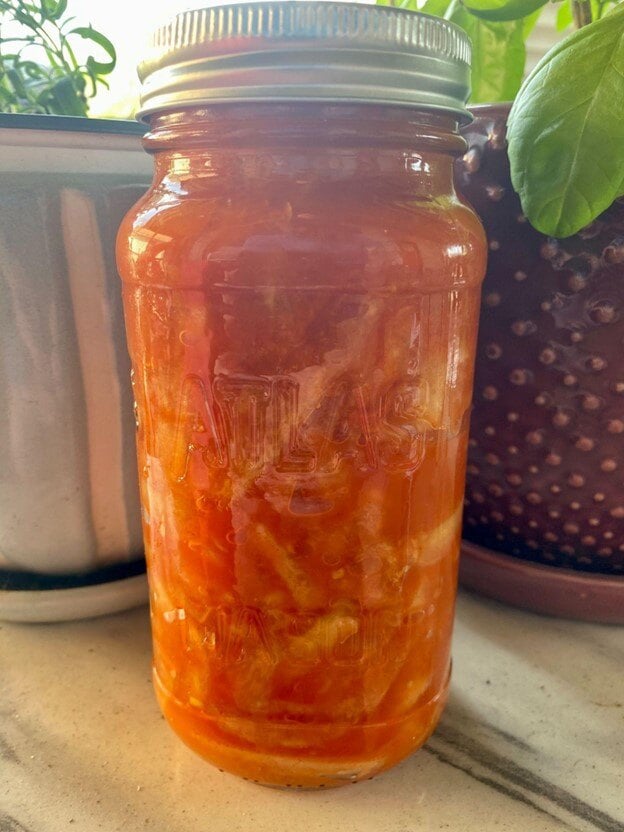In the array of Korean cuisine, one dish reigns supreme: Kimchi. It's a versatile staple, gracing tables as a side or condiment for nearly every meal. Traditionally, it's made with Napa cabbage or radishes, undergoing fermentation with gochugaru chiles, garlic, ginger, and sesame. Yet, kimchi's charm lies in its adaptability, allowing for creative twists with various fruits and vegetables.

In addition to its culinary prowess, kimchi holds a profound cultural significance in Korean society, symbolizing resilience, community, and the art of preserving seasonal harvests for sustenance throughout the year. Along my culinary journey, I've discovered that watermelon rinds are a fantastic and virtually free canvas for infusing those bold and tangy Eastern flavors. The next time you cut up a watermelon, there is no reason to throw the scraps away!
At the heart of this fermentation lies Lactobacillus, a type of beneficial bacteria abundant in kimchi-making. Lactobacillus converts sugars present in the vegetables into lactic acid, which not only imparts that characteristic tangy flavor but also serves as a natural preservative. This lactic acid environment created during fermentation not only enhances the flavor and texture of kimchi but also contributes to its numerous health benefits.
Lactobacillus is a probiotic powerhouse, known for promoting gut health by balancing the microbiome, aiding digestion, and bolstering the immune system. By creating a highly saline environment during fermentation, harmful bacteria are inhibited, allowing the beneficial bacteria like Lactobacillus to thrive. As a result, kimchi becomes not just a flavorful condiment but also a potent elixir of wellness, enriching both body and soul with each crunchy, tangy bite.
 For a simple idea of lacto-fermentation, let's explore watermelon rinds as our starting point. We begin by thoroughly cleaning and slicing the white part of the watermelon rinds into bite-sized pieces. Then we place these pieces in a clean, non-reactive container. To the weight of the rinds, we then add approximately 2-3% of salt by weight, ensuring even distribution throughout the container. The salt serves a dual purpose: it draws out moisture from the rinds to create a brine and creates an environment conducive to the growth of beneficial bacteria while inhibiting harmful ones.
For a simple idea of lacto-fermentation, let's explore watermelon rinds as our starting point. We begin by thoroughly cleaning and slicing the white part of the watermelon rinds into bite-sized pieces. Then we place these pieces in a clean, non-reactive container. To the weight of the rinds, we then add approximately 2-3% of salt by weight, ensuring even distribution throughout the container. The salt serves a dual purpose: it draws out moisture from the rinds to create a brine and creates an environment conducive to the growth of beneficial bacteria while inhibiting harmful ones.
Once our mixture is complete, we cover the container loosely and allow it to ferment at room temperature for several days, typically around 3 to 7 days, depending on personal preference. During this time, the naturally occurring lactobacillus bacteria will flourish, transforming the watermelon rinds into tangy, probiotic-rich treats through the process of lacto-fermentation.
 Chef’s note: using a kitchen scale is imperative to a successful fermentation process. All weights are measured in grams to ensure appropriate proportions and promote a healthy and safe fermentation.
Chef’s note: using a kitchen scale is imperative to a successful fermentation process. All weights are measured in grams to ensure appropriate proportions and promote a healthy and safe fermentation.
Watermelon Rind Kimchi
Scroll down for a printable version of this recipe
Yield: approximately 3 cups
Prep time: 20-30 minutes
Inactive time: 4-7 days
500 grams watermelon rinds, removed from the green skin and sliced into thin, bite-sized pieces.
12 grams coarse salt
50 grams watermelon juice (easily obtained from squeezing a few chunks of fruit)
15 grams grated ginger
5 garlic cloves, thinly sliced
60 grams gochujang paste
2 Thai chilis, thinly sliced (optional)
1. Prepare the Watermelon Rinds:
- Thoroughly wash the watermelon rinds to remove any dirt or debris.
- Using a sharp knife, filet the white rind flesh away from the green outer skin and slice the rinds into thin, bite-sized pieces.
- Place the sliced rinds into a glass or steel mixing bowl. Add salt and toss to coat, allowing the rinds to sit for a few minutes to begin to release some of their water.
 2. Mix the Seasonings:
2. Mix the Seasonings:
- In a mixing bowl, combine the watermelon juice, grated ginger, thinly sliced garlic cloves, gochujang paste, and sliced Thai chilis (if using).
- Stir the mixture until all the ingredients are well combined and the gochujang paste is evenly distributed.
- Pour the seasoning mixture over the watermelon rinds, ensuring that all the pieces are thoroughly coated with the seasoning.

- Transfer the seasoned watermelon rinds into a clean, airtight container or glass jar.
- Press down gently on the rinds to remove any air pockets and ensure they are submerged in the seasoning liquid.
- Seal the container or jar loosely and allow the watermelon rinds to ferment at room temperature for 4-7 days. Check the kimchi periodically and taste for desired fermentation level.
- Once the watermelon rind kimchi has reached your desired level of fermentation, transfer it to the refrigerator to slow down the fermentation process.
- Enjoy!
Kimchi can be eaten with grilled meats, on sandwiches, mixed into soups, or simply on its own. I always like to keep some in the fridge for Bibimbap night at our home!
 I hope that this recipe can be an inspiration for you to create something delicious out of an item that would usually be thrown away. Use this formula to create your own fermented favorites and comment your experiences below.
I hope that this recipe can be an inspiration for you to create something delicious out of an item that would usually be thrown away. Use this formula to create your own fermented favorites and comment your experiences below.
For more information on lacto-fermentation and kimchi check out our Executive Chef/Owner Lisa Count’s blog about her journey through the process and for more Korean inspired recipes, check out our hands-on Korean BBQ on the Grill class on Saturday, July 27 at 6pm at Lincoln Square.

Watermelon Rind Kimchi
Ingredients
- 500 grams watermelon rinds, removed from the green skin and sliced into thin, bite-sized pieces.
- 12 grams coarse salt
- 50 grams watermelon juice (easily obtained from squeezing a few chunks of fruit)
- 15 grams grated ginger
- 5 garlic cloves, thinly sliced
- 60 grams gochujang paste
- 2 Thai chilis, thinly sliced (optional)
Instructions
- Thoroughly wash the watermelon rinds to remove any dirt or debris.
- Using a sharp knife, filet the white rind flesh away from the green outer skin and slice the rinds into thin, bite-sized pieces.
- Place the sliced rinds into a glass or steel mixing bowl. Add salt and toss to coat, allowing the rinds to sit for a few minutes to begin to release some of their water.
- In a mixing bowl, combine the watermelon juice, grated ginger, thinly sliced garlic cloves, gochujang paste, and sliced Thai chilis (if using).
- Stir the mixture until all the ingredients are well combined and the gochujang paste is evenly distributed.
- Pour the seasoning mixture over the watermelon rinds, ensuring that all the pieces are thoroughly coated with the seasoning.
- Transfer the seasoned watermelon rinds into a clean, airtight container or glass jar.
- Press down gently on the rinds to remove any air pockets and ensure they are submerged in the seasoning liquid.
- Seal the container or jar loosely and allow the watermelon rinds to ferment at room temperature for 4-7 days. Check the kimchi periodically and taste for desired fermentation level.
- Once the watermelon rind kimchi has reached your desired level of fermentation, transfer it to the refrigerator to slow down the fermentation process.











